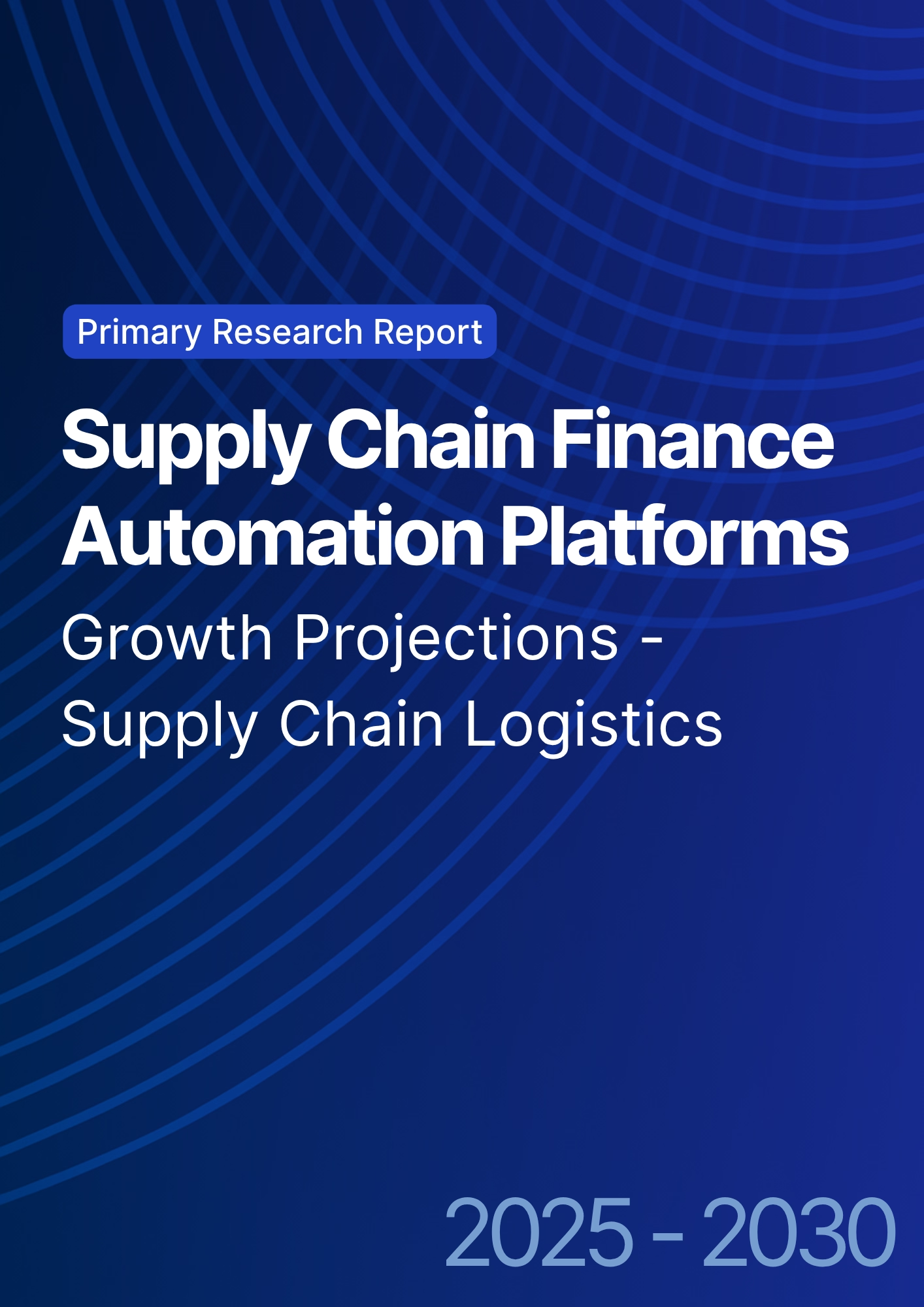

68 Circular Road, #02-01 049422, Singapore
Revenue Tower, Scbd, Jakarta 12190, Indonesia
4th Floor, Pinnacle Business Park, Andheri East, Mumbai, 400093
Cinnabar Hills, Embassy Golf Links Business Park, Bengaluru, Karnataka 560071
Connect With Us
Supply Chain Finance Automation Platforms: Growth Projections - Supply Chain Logistics
This research examines the growth of supply chain finance automation platforms in US and North America from 2025 to 2030. The report highlights the projected market growth, automation trends, and cost-saving benefits for businesses utilizing these platforms. It focuses on how digitalization and AI-powered solutions streamline supply chain financing, optimize cash flow, and improve operational efficiency. The study provides actionable insights for business leaders, investors, and technology providers looking to capitalize on the rise of supply chain finance automation.

What's Covered?
Report Summary
Key Takeaways
- Supply chain finance automation market in North America projected to grow from $2.1 billion in 2025 to $9.5 billion by 2030, CAGR 34%.
- AI-powered automation expected to increase supply chain financing efficiency by 40% by 2030.
- Cost savings from supply chain finance automation expected to reach $4 billion annually in North America by 2030.
- Digital platforms for supply chain finance expected to account for 70% of the market by 2030.
- Supply chain finance transaction volumes projected to increase by 50% annually by 2030.
- Automated invoice management will reduce manual processing errors by 30% by 2030.
- Banks and financial institutions are expected to account for 60% of total investments in supply chain finance automation by 2030.
- Digital financing solutions will improve working capital efficiency for SMEs by 20% by 2030.
- Cross-border supply chain finance expected to grow by 35% as automation platforms enhance global transaction processing.
- ROI from automation adoption in supply chain finance projected at 18–22% by 2030.
Key metrics
Market Size & Share
The supply chain finance automation market in North America is expected to grow significantly from $2.1 billion in 2025 to $9.5 billion by 2030, reflecting a CAGR of 34%. The growing demand for digital finance solutions and the increasing adoption of AI-powered automation in supply chain financing will drive this growth. By 2030, AI-powered platforms will enhance the efficiency of supply chain finance operations, increasing efficiency by 40%. This will result in $4 billion annually in cost savings across the North American supply chain finance sector. Digital platforms are projected to capture 70% of the market share by 2030, offering businesses real-time invoice financing, automated reporting, and improved cash flow management. The transaction volume in supply chain finance will grow at 50% annually as businesses scale their operations through automation. By 2030, automated invoice management is expected to reduce manual processing errors by 30%, minimizing operational disruptions and improving the accuracy of financial transactions. Banks and financial institutions will contribute 60% of total investments into supply chain finance automation by 2030, recognizing the potential for improved compliance, faster transactions, and lower operational costs. The ROI from adopting automation solutions is projected to reach 18–22% by 2030, driven by improved efficiency and cost reductions across supply chain operations.
.png)
Market Analysis
The supply chain finance automation market is experiencing rapid growth in North America, expected to rise from $2.1 billion in 2025 to $9.5 billion by 2030, reflecting a CAGR of 34%. This growth is driven by AI-powered solutions that enhance the efficiency of supply chain finance processes, including invoice management, payment processing, and risk analysis. Automated platforms will reduce manual errors by 30% and improve transaction speed by 60% by 2030. Cost savings of $4 billion annually will be achieved by reducing processing costs, interest payments, and manual labor. By 2030, digital platforms will account for 70% of the market share, providing businesses with scalable, efficient tools for managing supply chain finance. Cross-border compliance is expected to improve by 40%, enabling businesses to manage global supply chains more efficiently and securely. Banks and financial institutions will invest heavily in RegTech solutions, contributing 60% of the total market share by 2030. These solutions will help financial institutions and small-to-medium enterprises (SMEs) manage working capital more effectively, improving liquidity and reducing dependency on traditional financing methods. By 2030, ROI for supply chain finance automation is projected at 18–22%, driven by enhanced operational efficiency, risk mitigation, and cost savings.
Trends & Insights
The supply chain finance automation market is projected to experience robust growth in North America, with an expected rise from $2.1 billion in 2025 to $9.5 billion by 2030, representing a CAGR of 34%. Key trends include the growing reliance on AI-powered platforms for invoice financing, automated risk analysis, and transaction monitoring, which will improve supply chain finance efficiency by 40% by 2030. Digital platforms will dominate the market, capturing 70% of total market share, driven by their ability to provide real-time processing, better risk management, and more cost-effective solutions. The transaction volume in supply chain finance will increase at a rate of 50% annually by 2030, as businesses adopt automated financing solutions to scale their operations. Cost savings of €4 billion annually will be achieved by reducing the reliance on manual processes and improving cash flow. Banks and financial institutions will account for 60% of total investments in RegTech solutions for supply chain finance by 2030. SMEs will also benefit from these advancements, with working capital efficiency improving by 20% by 2030. The ROI for supply chain finance automation adoption will reach 18–22% by 2030, driven by improved cost management, operational efficiency, and enhanced cross-border compliance.
.png)
Segment Analysis
The supply chain finance automation market is segmented by technology type, institution size, and geographic region. In North America, the adoption of AI-powered automation platforms is expected to drive growth, with digital solutions capturing 70% of the market share by 2030. By 2030, banks, fintech firms, and insurance providers will dominate the market, contributing 60% of investments into supply chain finance automation solutions. These institutions will use AI-powered models to enhance risk mitigation, invoice financing, and payment processing, improving operational efficiency by 40% and reducing manual errors by 30%. Small-to-medium enterprises (SMEs) will benefit from digital financing solutions, improving working capital efficiency by 20%. By 2030, cross-border supply chain finance is expected to grow by 40%, as automation platforms enhance global transaction processing and improve compliance across international jurisdictions. Transaction volumes are projected to increase by 50% annually, reflecting the growing adoption of automation in global supply chains. ROI from supply chain finance automation is projected to reach 18–22% by 2030, driven by reduced operational costs, faster transactions, and better working capital management.
Geography Analysis
The supply chain finance automation market in North America is set to grow rapidly, with the market expected to reach $9.5 billion by 2030, up from $2.1 billion in 2025. The rise of AI-powered platforms will enhance supply chain finance efficiency by 40%, improving operational productivity and reducing costs. The adoption of digital platforms is projected to account for 70% of the market share by 2030. Cross-border compliance will increase by 40%, as RegTech platforms enable seamless integration of supply chain finance systems across EU and North American jurisdictions. SMEs will experience working capital efficiency gains of 20% by 2030, as automation platforms provide better liquidity management solutions. By 2030, transaction volumes are expected to rise by 50% annually, driven by greater adoption of automated financing solutions. Cost savings from supply chain finance automation will reach €4 billion annually, offering financial institutions and businesses more flexibility in managing their supply chains. ROI for supply chain finance automation adoption is projected to be 18–22% by 2030, driven by reduced operational costs, faster processing times, and more accurate cross-border compliance.
.png)
Competitive Landscape
The supply chain finance automation market in North America is highly competitive, with major players such as Finastra, ACI Worldwide, SWIFT, and Tradeshift offering AI-powered platforms for supply chain finance. These companies will dominate the market, providing real-time payment solutions, invoice financing, and risk management tools for financial institutions and businesses. Banks and payment service providers (PSPs) will account for 60% of total investments in the market by 2030. The ROI from supply chain finance automation is projected to be 18–22% by 2030, driven by reduced operational costs, improved cash flow management, and better transaction monitoring. The competitive advantage in this market will go to companies that offer scalable, integrated solutions that meet the needs of cross-border financial transactions and global supply chain operations. As digital platforms drive increased transaction volume, financial institutions will continue to invest in automated supply chain finance systems to reduce costs, improve efficiency, and offer better compliance solutions for both local and global operations. ROI will be driven by increased transaction processing speeds, improved liquidity management, and better working capital efficiency for small-to-medium enterprises (SMEs).
Report Details
Proceed To Buy
Want a More Customized Experience?
- Request a Customized Transcript: Submit your own questions or specify changes. We’ll conduct a new call with the industry expert, covering both the original and your additional questions. You’ll receive an updated report for a small fee over the standard price.
- Request a Direct Call with the Expert: If you prefer a live conversation, we can facilitate a call between you and the expert. After the call, you’ll get the full recording, a verbatim transcript, and continued platform access to query the content and more.


68 Circular Road, #02-01 049422, Singapore
Revenue Tower, Scbd, Jakarta 12190, Indonesia
4th Floor, Pinnacle Business Park, Andheri East, Mumbai, 400093
Cinnabar Hills, Embassy Golf Links Business Park, Bengaluru, Karnataka 560071
Request Custom Transcript
Related Transcripts
$ 1450
$ 1450


68 Circular Road, #02-01 049422, Singapore
Revenue Tower, Scbd, Jakarta 12190, Indonesia
4th Floor, Pinnacle Business Park, Andheri East, Mumbai, 400093
Cinnabar Hills, Embassy Golf Links Business Park, Bengaluru, Karnataka 560071





.png)







